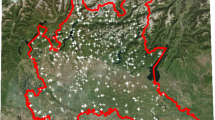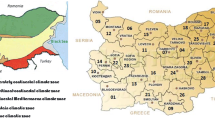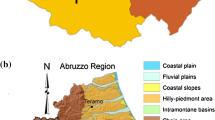Abstract
Radon-222 is a noble gas arising naturally from decay of uranium-238 present in the earth’s crust. In confined spaces, high concentrations of radon can become a serious health concern. Hence, experts widely agree that prolonged exposure to this gas can significantly increase the risk of lung cancer. A range of variables, such as geological factors, soil properties, building characteristics, the living habits of dwellers and meteorological parameters, might have a significant impact on indoor radon concentration and its variability. In this paper, the effect of various factors that are believed to influence the indoor radon concentrations is studied at the municipal level of L’Aquila district (Abruzzo region, Italy). The statistical analysis is carried out through a hierarchical Bayesian spatial quantile regression model in which the matrix of explanatory variables is partially defined through a set of spatial common latent factors. The proposed model, here referred to as the Generalized latent-spatial-quantile regression model, is thus appropriate when some covariates are indicators of latent factors that can be used as predictors in the quantile regression and the variables are supposed to be spatially correlated. It is shown that the model has an intuitive appeal and that it is preferable when the interest is in studying the effects of covariates on one or both the tails of the response distribution, as in the case of indoor radon concentrations. Full probabilistic inference is performed by applying Markov chain Monte Carlo techniques.




Similar content being viewed by others
Notes
Member states of European Union, for example, have to establish national reference levels for annual average indoor radon concentration not exceeding the value of 300 Bq/m3 fixed by the Directive 2013/59/Euratom.
References
Appleton J, Miles JCH, Green BMR, Larmour R (2008) Pilot study of the application of tellus airborne radiometric and soil geochemical data for radon mapping. J Environ Radioact 99(10):1687–1697
Appleton JD, Miles JCH (2010) A statistical evaluation of the geogenic controls on indoor radon concentrations and radon risk. J Environ Radioact 101(10):799–803
Appleton JD, Miles JCH, Young M (2011) Comparison of Northern Ireland radon maps based on indoor radon measurements and geology with maps derived by predictive modelling of airborne radiometric and ground permeability data. Sci Total Environ 409(8):1572–1583
Bellotti E, Di Carlo G, Di Sabatino D, Ferrari N, Laubenstein M, Pandola L, Tomei C (2007) γ-Ray spectrometry of soil samples from the provincia dell’aquila (Central Italy). Appl Radiat Isot 65(7):858–865
Bochicchio F, Campos G, Venuti C, Nuccetelli C, Piermattei S, Risica S, Tommasino L, Torri G (1996) Results of the representative Italian National Survey on radon indoors. Health Phys 71(5):741–748
Bollen K (1989) Structural equations with latent variables. Wiley, New York
Borgoni R (2011) A quantile regression approach to evaluate factors influencing residential indoor radon concentration. Environ Model Assess 16:239–250
Darby S, Hill D, Auvinen A, Barros-Dios JM, Baysson H, Bochicchio F, Deo H, Falk R, Forastiere F, Hakama M, Heid I, Kreienbrock L, Kreuzer M, Lagarde F, MSkelSinen I, Muirhead C, Oberaigner W, Pershagen G, Ruano-Ravina A, Ruosteenoja E, Rosario AS, Tirmarche T, Tomsek L, Whitley E, Wichmann HE, Doll R (2005) Radon in homes and risk of lung cancer: collaborative analysis of individual data from 13 European case–control studies. Br Med J 330:7485
Fennell SG, Mackin GM, Madden JS, McGarry AT, Duffy JT, O’Colmin M, Colgan PA, Pollard D (2002) Radon in dwellings. The Irish National Radon Survey Report RPII-02/1, Radiological Protection Institute of Ireland.
Friedmann H (2005) Final results of the Austrian radon project. Health Phys 89(4):339–348
Gelman A (1996) Inference and monitoring convergence. In: Gilks WR, Richardson S, Speigelhalter DJ (eds) Introducing Markov chain Monte Carlo. Chapman and Hall, London, pp 131–143
Green BMR, Miles JCH, Bradley EJ, Rees DM (2002) Radon atlas of England and Wales. Report nrpb-w26, Chilton NRPB.
Gunby JA, Darby SC, Miles JCH, Green BM, Cox DR (1993) Factors affecting indoor radon concentrations in the United Kingdom. Health Phys 64:2–11
Hallin M, Lu Z, Yu K (2009) Local linear spatial quantile regression. Bernoulli 15(3):659–686
Ielsch G, Cushing ME, Combes PH, Cuney M (2010) Mapping of the geogenic radon potential in France to improve radon risk management: methodology and first application to region Bourgogne. J Environ Radioact 101:813–820
Ippoliti L, Valentini P, Gamerman D (2012) Space-time modelling of coupled spatiotemporal environmental variables. J R Stat Soc 61:175–200
Kemski J, Klingel R, Siehl AR (1996) Classification and mapping of radon-affected areas in Germany. Environ Int 22:S789–S798
Kemsky J, Klingel R, Siehl AR, Valdivia-Manchego M (2009) From radon hazard to risk prediction-based on geological maps, soil gas and indoor measurements in Germany. Environ Geol 56(7):1269–1279
Koenker R, Bassett G (1978) Regression quantiles. Econometrica 46(1):33–50
Koenker R, Machado JAF (1999) Goodness of fit and related inference processes for quantile regression. J Am Stat Assoc 94(448):1296–1310
Koop G (2013) Bayesian econometrics. Wiley, Chichester
Kreienbrock L, Kreuzer M, Gerken M, Dingerkus G, Wellmann J, Keller G, Wichmann HE (2001) Case-control study on lung-cancer and residential radon in Western Germany. Am J Epidemiol 89(4):339–348
Krewski D, Lubin JH, Zielinski JM, Alavanja M, Catalan VS, Field RW, Klotz JB, Letourneau EG, Lynch CF, Lyon JJ, Sandler DP, Schoenberg DJ, Steck JA, Stolwijk C, Weinberg C, Wilcox HB (2005) Residential radon and risk of lung cancer: a combined analysis of seven North American case–control studies. Epidemiology 16(4):137–145
Kuzobowski TJ, Podgorski K (2000) A multivariate and asymmetric generalization of Laplace distribution. Comput Stat 15(4):531–540
Liu X, Wall MM, Hodges JS (2005) Generalized spatial structural equation modeling. Epidemiology 6:539–557
Lopes HF, Salazar E, Gamerman D (2011) Generalized spatial dynamic factor models. Comput Stat Data Anal 55:1319–1330
Lubin J, Boice JD (1997) Lung cancer risk from residential radon: a meta-analysis of eight epidemiological studies. J Natl Cancer Inst 89(1):49–57
Lum K, Gelfand E (2012) Spatial quantile multiple regression using the asymmetric Laplace process. Bayesian Anal 7(2):235–258
Palermi S, Pasculli A (2008) Radon mapping in abruzzo, italy. In: Proceedings of 4th Canadian conference on geohazards, QuTbec City.
Pasculli A, Palermi S, Sarra A, Piacentini T, Miccadei E (2013) A novel modelling methodology for the analysis of radon potential based on environmental geology and Geographically Weighted Regression approach. Environ Model Softw 54:165–181
Reed C, Yu K (2009) An efficient gibbs sampling for bayesian quantile regression. Department of Mathematical Sciences, Brunel University, Technical report
Reich BJ, Fuentes M, Dunson DB (2012) Bayesian spatial quantile regression. J Am Stat Assoc 106(493):6–20
Rowe JE, Kelly M, Price LE (2002) Weather system scale variation in Radon-222 concentration of indoor air. Sci Total Environ 284(1–3):157–166
Sarra A, Nissi E, Palermi S (2012) Residential radon concentration in the Abruzzo region (Italy): a different perspective for identifying radon prone areas. Environ Ecol Stat 19:219–247
Smethurst MA, Strand T, Sundal AV, Rudjord AL (2008) Large-scale radon hazard evaluation in the Oslofjord region of Norway utilizing indoor radon concentrations, airbone gamma spectrometry and geological mapping. Sci Total Environ 407:379–393
Sriram K, Ramamoorthi RV, Ghosh P (2013) Posterior consistency of Bayesian quantile regression based on the misspecified asymmetric Laplace density. Bayesian Anal 8(2):479–504
Tiefelsdorf M (2007) Controlling for migration effects in ecological disease mapping of prostate cancer. Stoch Environ Res Risk Assess 21:615–624
USEPA (1992) National residential radon survey: summary report. Technical Report EPA/402/R-92/011, United States Environmental Protection Agency, Washington, DC.
Wang F, Wall MM (2003) Generalized common spatial factor model. Biostatistics 4:569–582
Weltner A, Makelainen I, Arvela H (2002) Radon mapping strategy in Finland. In Burkart W., Sohrabi M., Bayer A., eds. High levels of natural radiation and radon areas: Radiation dose and health effects. In: Proceedings of the 5th international conference high levels of natural radiation and radon areas. Munich, 47 Sept, 2002. International Congress Series 1225, pp 63–69.
White SB, Bergsten JW, Alexander BV, Rodman NF, Phillips JL (1992) Indoor -222 Rn concentrations in a probability sample of 43,000 houses across 30 states. Health Phys 62(1):41–50
Young LJ, Gotway CA (2007) Controlling for migration effects in ecological disease mapping of prostate cancer. Stoch Environ Res Risk Assess 21:589–600
Yu K, Moyeed RA (2001) Bayesian quantile regression. Stat Prob Lett 54:437–447
Acknowledgments
We are grateful to the reviewers for their useful comments and suggestions which have significantly improved the quality of the paper. L. Fontanella, L. Ippoliti, A. Sarra and P. Valentini acknowledge the financial support of MIUR, Ministero dell’Istruzione, dellUniversità e della Ricerca, FIRB (Futuro in Ricerca) research project Statistical modeling of environmental phenomena: pollution, meteorology, health and their interactions—StEPhI Project. This paper is dedicated to the memory of our colleague G. Visini.
Author information
Authors and Affiliations
Corresponding author
Electronic supplementary material
Below is the link to the electronic supplementary material.
Rights and permissions
About this article
Cite this article
Fontanella, L., Ippoliti , L., Sarra, A. et al. Hierarchical generalised latent spatial quantile regression models with applications to indoor radon concentration. Stoch Environ Res Risk Assess 29, 357–367 (2015). https://doi.org/10.1007/s00477-014-0917-0
Published:
Issue Date:
DOI: https://doi.org/10.1007/s00477-014-0917-0




